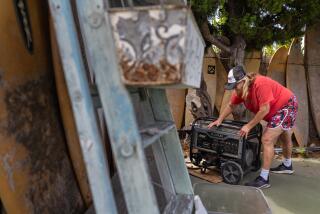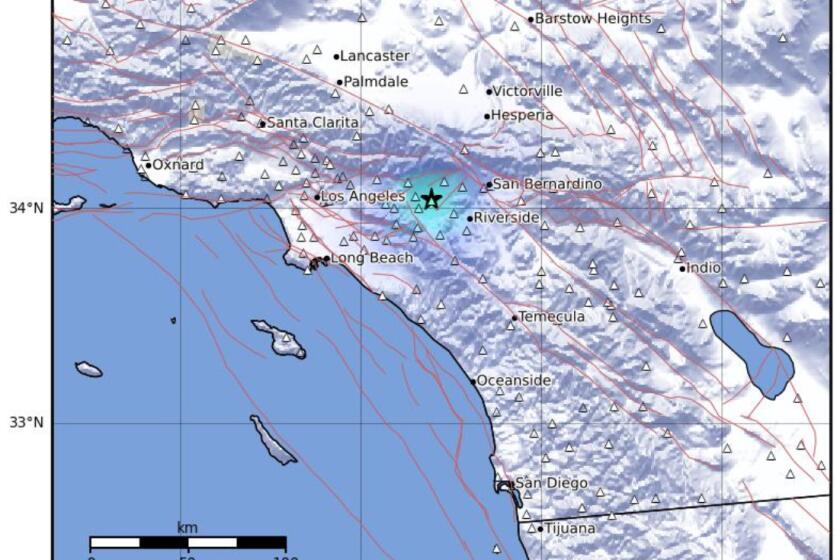Now Comes Task of Fixing Many Thousands of Homes
SANTA CRUZ — Wryly, Bill Christie remembers the first words he said to himself when he drove home after last week’s earthquake.
“Oh, great, my house is spared,” he thought. Indeed, from the driveway, Christie’s $800,000 home in the pricey Carbonera Estates section of town looked fine.
It was this week that reality set in. Like a virus, hundreds of tiny cracks had subtly pulled the 10-year-old home apart. Windows didn’t fit. Bricks were torn loose. An engineer came by Tuesday. Don’t spend five more minutes there, he said. You’re going to have to demolish. Christie, a dentist, moved his family that night.
Beyond the deaths that have stained Northern California, beyond the horrific scenes that have filled television screens for a week, hundreds of thousands of residents are beginning to deal with the less dramatic but still agonizing problem of rehabilitating their homes.
They range from major losses like Christie’s to smaller ones. There’s the old church in Watsonville that Patrick Aherne, a painter, turned into a studio, only to find his materials and collection of rare glassware thrown into ruin and a chunk of concrete dangling dangerously over the sidewalk.
There is the wood-framed home that Frans Waterlander, a computer company engineer, bought as income property in a middle-class section of Santa Cruz. It didn’t move from its foundation much--just an inch--but the foundation’s underpinnings are damaged.
Much of the loss defies casual observation, and it is one reason why estimates of damage from the quake continue to conflict.
This week, for example, the state Office of Emergency Services estimated that 110,000 houses in Northern California had been damaged, but Santa Clara County officials said that in their county alone 104,000 homes--one in three--had sustained some sort of damage.
According to contractors and engineers, as many as two-thirds of older homes in Santa Cruz and Santa Clara counties, the regions closest to the quake’s epicenter, suffered damage.
Some homeowners may not have reported damage to building officials, either because they are still traumatized by the quake or because they fear that an inspection would find their home uninhabitable and force them to join thousands who have been left homeless, these experts suggest.
“I think the estimate of damaged houses is incredibly low,” said Charles Stewart, a civil engineer, as he inspected a friend’s damaged Victorian house in downtown Los Gatos on Tuesday evening. The home was off level and in need of $40,000 of work. It wasn’t safe to live in, Stewart said, yet his friend was staying.
As was the case two years ago when the Whittier earthquake struck the Los Angeles area, many unsophisticated homeowners have been suddenly plunged into a new vocabulary of “framing members,” “cross bracing” and “cripple walls,” to say nothing of the bureaucratic maze of federal loan applications. The nuances seem to echo through every restaurant and bar.
So, too, does the subject of how to find a contractor, who are in such heavy demand that some of them have begun the unusual practice of charging for inspections.
Tales of outside firms hustling into quake territory are already circulating. A Bakersfield construction firm shoved flyers under the windshields of cars in San Francisco’s devastated Marina District hours after the quake. A veteran contractor said his fax machine has been receiving a flood of solicitations from supply companies. The head of a carpenters’ union local said his office has been receiving inquiries from workmen outside the area.
Authorities are warning homeowners not to rush into deals.
“We’re trying to warn people that the con artists are coming out of whatever woodwork you have left,” said Laurel Pallock, an investigator in the consumer protection unit of the San Francisco district attorney’s office, which has investigated everything from price-gouging (a pocket flashlight being sold for $8) to some men who tried to steal from elderly residents by posing as utility inspectors.
The Contractors’ State License Board in San Francisco distributed its own flyer, urging homeowners to demand proof of a contractor’s license, to ask for local references, to get three bids and to remember that under state law contractors cannot ask for more than $1,000 in up-front payment.
The same warnings were made by authorities in Los Angeles two years ago after the Whittier quake damaged 10,000 homes in the county. Yet “we heard countless stories about contractors who took payment, started work and didn’t finish, did shoddy work or didn’t take out the necessary permits,” said Richard Hubinger, director of Whittier’s building and safety department.
Individual homeowners do not appear to be moving as quickly to find contractors as they did in Whittier. For one thing, the damage area is spread out over a swath 75 miles long, and landslides have cut off sections from each other, delaying delivery of supplies and the pace of insurance inspections. For another, rain on Monday and Tuesday slowed progress.
Still, many masonry contractors are receiving 50 calls a day and are booked a month or more in advance. Some general contractors are receiving far more calls. A specialty contractor such as Mark Wagner, who was working solo and specializing in building residential skylights, has made estimates on 30 general repair jobs in the last week in badly jolted Watsonville and has hired three men.
Even before the quake there were shortages of carpenters. It was so drastic that local union officials, whose members represent only a small fraction of the trade, put out a public appeal for workmen last month.
Not surprisingly, the disparity between supply and demand has created some unpleasant moments.
Christine McGuire, a Santa Cruz homeowner, was looking for a contractor to fix the brickwork that had fallen from the exterior of her home this week when she noticed a large newspaper ad for Apex Restoration. When she called, she was informed that she would have to pay $100 for an estimator to show up, and $50 an hour for the time he spent making the estimate.
McGuire, who happens to be an assistant Santa Cruz district attorney, complained to her office’s consumer affairs section, which telephoned Apex to informally caution it against violating state fair-business practices. In response, Apex’s co-owner, Mark Beaton, agreed to stop charging the estimate fee.
Beaton said in an interview that the fee was intended not to gouge homeowners but to protect his company against customers who simply wanted to obtain free estimates and then hire another contractor.
“The idea was that the cost of the inspection would be charged against the cost of the job if they hired us,” said Beaton, whose company is located in Capitola, an expensive suburb of Santa Cruz.
Like many contractors, Beaton was trying to walk a delicate line between profiting from the business boom the earthquake has created and not taking on more work than he can handle.
His 4-year-old company, which specializes in flood and fire restoration jobs referred by insurance companies and has a staff of 15, was suddenly receiving 100 calls a day and doing about three-dozen estimates a day.
In response, Beaton directed his staff to ask each caller a detailed set of questions so that he could screen out less-promising jobs and refer minor ones, such as chimney damage, to specialized contractors.
There are enough contractors to handle the region’s damage, Beaton said, but not if every homeowner wants the work done immediately.
“The wave (of calls) seemed to start on Friday,” he said. “I think it will keep up for the next three or four weeks. People have seen their (insurance) adjusters now and are moving. I’d say about 60% of the homes have some damage.”
The phone rang. The man on the other end needed a contractor. He had earthquake insurance, but the policy had the standard deductible of 10%, meaning in this case that the homeowner was responsible for the first $18,000.
He asked Beaton a touchy but not unprecedented question:
“Can you hide it?”
In other words, could Beaton inflate the estimate so that the insurance company would unwittingly eat the deductible?
Beaton said no, and the conversation ended.
BACKGROUND
Nine days after the Northern California earthquake struck, residents are turning their attention to the question of how to repair a myriad of structural problems ranging from small cracks to demolitions. They face frustrations that were common in Los Angeles two years ago after a quake centered near Whittier damaged 10,000 homes.
More to Read
Sign up for Essential California
The most important California stories and recommendations in your inbox every morning.
You may occasionally receive promotional content from the Los Angeles Times.










